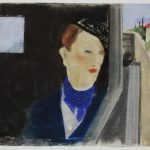January 27, 2022 | By Zachary D. Van Den Berg, MA, ATR-P, LPC-Associate & Pat B. Allen, PhD, ATR
On January 27, 1945, Soviet troops liberated Auschwitz, the largest of the Nazi concentration camps and killing centers. While Auschwitz was the largest concentration camp, it was only one of many liberated by Allied Forces in 1944 and 1945.
Nearly 80 years later, we continue to reckon with the scope of the atrocities and genocide that occurred during the Holocaust. Only since 2005, have the United Nations (UN) and its member states marked this anniversary and honored the six million Jewish victims of the Holocaust, and millions of other survivors and victims of Nazism on January 27, International Holocaust Remembrance Day (IHRD). And the international commemoration of the Holocaust is relatively new, indicating the continued work we all need to do in addressing diversity, inclusion, and recognizing our own history to advance social justice. This year’s IHRD theme is Memory, Dignity, and Justice, designated by the UN to explore how “preserving the historical record and challenging distortion are elements of claiming justice.”
Today, we reflect on the past to inform a meaningful critique of the present and ultimately imagine a future of justice. For art therapists, the question could be adapted to: How might art therapists remember our inherited professional past, rooted in the legacies of the Holocaust, to inform a meaningful critique of the present discourse in art therapy and imagine a future of justice for our clients and ourselves?
In this blog, we raise questions rather than provide answers to help recognize one among many influences on the emergence of art therapy as a profession in Europe and the US.
What was at stake in designing the new profession of art therapy? How might have the goal of gaining respect and standing in the unfolding mental health professions been influenced by the shadow of the World Wars and their aftermath?
Several figures who shaped the professionalization of art therapy in the United States, including Edith Kramer and Hanna Kwiatkowska, were directly affected by the Holocaust. In addition, a substantial number of influential founders were Jewish and impacted, albeit less directly, by this catastrophic legacy: Margaret Naumburg, Elinor Ulman, Bernie Levy, Felice Cohen, Arthur Robbins, Joseph Garai, Myra Levick, Judith Rubin, among many others, share Jewish heritage. As we place IHRD against our own memories of the foundations of art therapy, we hope to facilitate meaningful and critical discourse around the effects of Jewish trauma on the development of art therapy.
The words of Edith Kramer help us imagine how understanding our history in new ways as art therapists can advance social justice:
“In the face of the gap that separates our present from the culture and art that came to an end with the termination of World War II, how should we go on? Our historical situation is unfavorable. Art has always flourished best when it served some social function.”
What social function might art therapy serve in the present moment?
We can look to the resource Transcending Jewish Trauma, created by Jo Kent Katz, who has mapped a genealogy of internalized anti-Semitism for White Ashkenazi Jews in the US. According to Katz:
“Healing comes through our exploration of the trauma we’ve experienced, the trauma we’ve inherited, and the ways we enact this suffering on ourselves and one another as a result.”
Perhaps Friedl Dicker Brandeis, Edith Kramer’s beloved teacher, who was murdered in Auschwitz, gives us a clue.

“Lady in a car / Imaginary self-portrait,” Friedl Dicker-Brandeis, c. 1940, From the Jewish Museum, Prague. This image visualizes our textual inquiry of the cultural value of engaging in critical remembrance. As we individually and collectively contemplate how art therapists remember our inherited professional past to inform a meaningful critique of the present to ultimately imagine a future of justice, we can engage in the narrative metaphor crafted in Friedl Dicker-Brandeis’s image, “Lady in a car / Imaginary Self-Portrait”. To me (ZV), this painting tells as a story of a “Lady in a car” in motion, going from someplace to someplace. Any individualizing features are obscured in favor of gestural invitations for identification, one with lavish and rich elegance and privilege. Alone in this car, she softly gazes towards a horizon unknown. I believe she joins us on the journey towards remembrance, critique, and hope—unsatisfied with the here-and-now of violence, inequity, and injustice. Note her watery expression, her emotive expression, her curled eyebrow. This image could be read as a metaphor of the collapse of linear temporality through the creative process, to imagine the utopic possibility of a world that is more livable, one which nourishes the diversity of justice.
Her belief that the creative process, even in a concentration camp, could help to preserve human dignity and connection to the life force is confirmed by the writings of many of the children she taught who survived. However, Friedl, and so many, many other creative people, were annihilated.
Therefore, we must ask:
- Were the choices made to align art therapy with a strictly medical model partly a product of unexamined and unhealed trauma in individuals and in the culture?
- What are the possibilities/implications if the answers to the first two questions are yes?
- What do those early choices mean to us today—individually or as a profession?
- How does this history intersect with other global realities of trauma, genocide, and slavery guided by colonial and supremacist pursuits?
- How do the effects of intergenerational trauma affect the collective?
As we critically position the history of art therapy against our remembrance of the Holocaust, we can elucidate the range of effects that internalized anti-Semitism of White Ashkenazi Jewish art therapists had on the subordination and erasure of the role and impact of practitioners of color on the early development of the profession. By understanding how our past informs our present and identifying what conscious choices can we make together to support our future is part of the work that the profession and association are engaging in now. As we continue to explore the historical record, may we critique with compassion and reinvent with courage an art therapy centered in justice.
Zachary D. Van Den Berg
 Zachary D. Van Den Berg, MA, ATR-P, LPC-Associate has an MA in counseling/art therapy from Adler University and a BFA from the School of the Art Institute. He is past-president of the Adler art therapy student association, founder of the international online forums Art Therapy Students Associated and Coalition for Queer Creative Arts Therapies, current chair of the multicultural committee of the AATA, and creative director of the Expressive Media Film Library. He works at CommunityArts, LLC, a group art therapy and counseling practice in Austin, TX.
Zachary D. Van Den Berg, MA, ATR-P, LPC-Associate has an MA in counseling/art therapy from Adler University and a BFA from the School of the Art Institute. He is past-president of the Adler art therapy student association, founder of the international online forums Art Therapy Students Associated and Coalition for Queer Creative Arts Therapies, current chair of the multicultural committee of the AATA, and creative director of the Expressive Media Film Library. He works at CommunityArts, LLC, a group art therapy and counseling practice in Austin, TX.
Pat B. Allen
 Pat B. Allen, PhD, ATR, is an author, artist, art therapist, and teacher who connects to the Creative Source through art and writing. Her books – Art Is a Way of Knowing (Shambhala 1995) and Art Is a Spiritual Path (Shambhala 2005) – explore the borders between art, psychology, spirituality, and social action and are considered classics in the field of expressive arts therapy. Her novel Cronation (Blue Jay Press, 2016) offers an inspiring vision of a world infused by the revolutionary creative energy of women. Author of numerous professional articles, Pat lectures and delivers workshops nationally and internationally. Her artwork has been exhibited in a wide variety of juried and invited exhibits. Pat co-founded the Open Studio Project in Chicago and of Studio Pardes in Oak Park, IL. She is currently Senior Consulting Faculty for the Jewish Studio Project, which was founded by her daughter, Rabbi Adina Allen. Pat is the delighted grandmother of Adina’s two boys, Remy and Tovi.
Pat B. Allen, PhD, ATR, is an author, artist, art therapist, and teacher who connects to the Creative Source through art and writing. Her books – Art Is a Way of Knowing (Shambhala 1995) and Art Is a Spiritual Path (Shambhala 2005) – explore the borders between art, psychology, spirituality, and social action and are considered classics in the field of expressive arts therapy. Her novel Cronation (Blue Jay Press, 2016) offers an inspiring vision of a world infused by the revolutionary creative energy of women. Author of numerous professional articles, Pat lectures and delivers workshops nationally and internationally. Her artwork has been exhibited in a wide variety of juried and invited exhibits. Pat co-founded the Open Studio Project in Chicago and of Studio Pardes in Oak Park, IL. She is currently Senior Consulting Faculty for the Jewish Studio Project, which was founded by her daughter, Rabbi Adina Allen. Pat is the delighted grandmother of Adina’s two boys, Remy and Tovi.
The views and opinions expressed by guest authors in this blog do not necessarily reflect the official policy or position of AATA.
